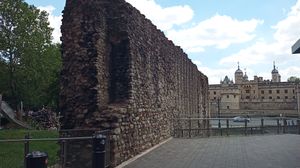
All Hallows Staining is an intriguing historic site nestled in the City of London, offering a unique glimpse into the layers of London's medieval past. The name "Staining" is thought to be derived from the Old English term 'stanig', meaning 'stone', setting it apart from other churches which were primarily wooden.
The church is notable for its surviving tower, which dates back to circa 1320. This ancient structure is a rare medieval relic amidst the modern skyline of London, and it bears witness to the many centuries of the city's growth and transformation.
All Hallows Staining was once a full church, but the building experienced several difficulties throughout its history, including structural instability. The main body of the church was demolished in 1870, leaving only its historic tower standing.
One fascinating aspect of All Hallows Staining is its resilience. It survived the Great Fire of London in 1666, which devastated much of the city, but eventually succumbed to its own structural weaknesses rather than the flames.
The site has connections to the ancient guild of Clothworkers. In an interesting twist, they have managed the tower and its surrounding property for centuries, linking the site to the broader narrative of London's trade and economic history.
For history buffs, the site also presents the opportunity to explore the collegiate tombs that were once part of the church's fixtures and are still maintained today, preserving a sense of medieval reverence.
While smaller and perhaps less well-known than some of London's grander religious sites, All Hallows Staining offers a rich tapestry of stories, hidden just off the beaten path in Mark Lane.

Making the Most of Your Visit:
Take a moment to admire the tower of All Hallows Staining from different angles. Its medieval architecture offers a distinct contrast against the modern backdrop of the City. You might even catch sight of some original stonework up close.
Keep an eye out for markers or plaques that hint at the history of the site; they often provide a deeper understanding of how the structure fits into the broader tale of London's past.
While on Mark Lane, imagine the hustle and bustle of the cloth traders who once frequented the area. This connection to the Clothworkers Guild is an insightful aspect of how commerce influenced the church's history.
If you have a moment, reflect on the resilience of the tower, one of the few structures in the area that withstood the Great Fire of 1666, yet was toppled by its own vulnerabilities in years following.
Visit during a quieter time of day if possible. The tranquility and historical aura of the site are best appreciated when you're able to pause and soak in the past without the rush of daily city life.

Visiting Times & Costs:
All Hallows Staining is generally not open to the public on a regular basis. The tower and its surrounding area are primarily managed by the Clothworkers Guild and may not have regular visiting hours like a traditional tourist attraction. Therefore, visiting may require special arrangements or be part of organized tours or events.
There is no entrance fee to view the exterior of All Hallows Staining, including its historic tower, from the public areas surrounding it. However, access to the interior or special tours might be subject to an event fee or booking requirement through specific organizers.
Accessibility for those with mobility concerns may be limited due to the historic nature of the site, particularly if interior access is ever part of a tour or event. Visitors should check for any special accommodations when planning their visit or any scheduled public access events.
For the latest availability, visitors might need to contact local tour companies or historical societies that might organize special access events.

Address & Map:

Nearby:























